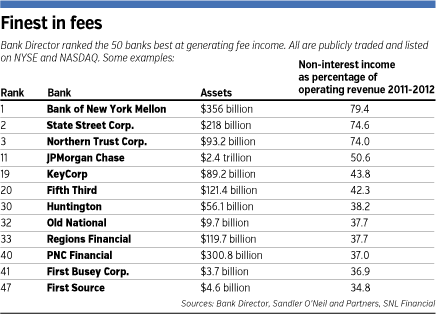Subscriber Benefit
As a subscriber you can listen to articles at work, in the car, or while you work out. Subscribe NowEarning a spot on this list probably won’t score points with bank customers who fret over ATM fees and other account charges.
But banks in Indiana that landed on Bank Director magazine’s “50 Best Fee Income Banks” list may win favor with shareholders at a time fee income is becoming more valuable to the bottom line.
Two Indiana-based banks showed up on the national ranking of best non-interest income as a percentage of operating revenue: Evansville-based Old National Bancorp and South Bend’s 1st Source Corp.
Old National ranked No. 32 by deriving 37.7 percent of its operating revenue from non-interest income in 2011-2012.
Typically, these can include fees for trust services, insurance products, asset servicing and ordinary account fees.
Meanwhile, 1st Source made the list at No. 47, with nearly 35 percent of its operating revenue from non-interest income.
The survey covered NYSE- and NASDAQ-listed banks.
The king of non-interest income was Bank of New York Mellon, at 79.4 percent.
Other banks scoring high, and with offices in Indiana, included JP Morgan Chase, at 11th-best, KeyCorp., 19th; Fifth Third, 20th; Huntington, 30th; Regions, 33rd; and PNC Financial, at 40th-best in non-interest income.
Fee-income might seem like nickels and dimes in the grander scheme of banking, but it is becoming more important. Interest rates on loans have declined sharply in recent years. And although the economy has improved, lending demand is still low relative to pre-recession days.
“That certainly squeezes your margins on the loan side of things,” said Randy Reichmann, president of Old National’s Indianapolis region.
“You have to replace that [interest income] with something. You can only cut costs for so long,” said Joe DeHaven, president of the Indiana Bankers Association.
Old National, which had profit of $23.9 million in the third quarter, generated $47.5 million in non-interest income in the period. The biggest chunk of that non-interest income was $18.9 million from fees in wealth management and insurance and investment products. Service charges on deposits added up to $13.9 million.
But the bank said it expects “downward pressure” on service charge income, citing newer federal regulations involving overdraft fees. Many banks automatically assessed a fee for overdraft protection, but customers now can more easily opt out of such protection plans.
Old National has to work harder to generate non-interest income, and part of that strategy is to leverage relationships with existing customers. Reichmann recalled how an existing client inquired about getting a loan to buy an airplane. Old National doesn’t yet offer airplane financing and instead usually makes a referral to another lender. But bank managers didn’t give up, pointing out Old National could arrange insurance on the aircraft.
 Cincinnati-based Fifth Third said it has enjoyed strong brokerage production and wealth management fees. Its corporate banking side also has seen growth contributing to non-interest income.
Cincinnati-based Fifth Third said it has enjoyed strong brokerage production and wealth management fees. Its corporate banking side also has seen growth contributing to non-interest income.
“When rates are low and spread compression is under pressure, our diverse revenue stream helps with momentum in keeping sustainable revenue growth,” said Randy Keeling, chief financial officer and senior vice president at Fifth Third’s central Indiana division.
But many smaller banks aren’t as fortunate as a Fifth Third or Old National (the latter with $9.7 billion in assets). It takes a certain amount of infrastructure to support fee-generating businesses such as sophisticated wealth management capabilities.
“They just don’t have the size. They don’t have the heft to be able to invest in the resources …. Trust officers don’t come cheap,” said DeHaven of the average $225-million-in-assets community bank.
Bank Director magazine said one big generator of fee income for banks is consumer products, including the oft-vilified ATM fees. It noted that federal restrictions on bank overdraft fees “have cut sharply into consumer-based fees at most banks.”
DeHaven noted that many banks no longer charge for certain checking accounts, after years of consumer complaints.
Another big category of fee income is in originating mortgages and auto loans and then selling the loans to third parties, “an especially strong driver for banks that took advantage of the booming refinancing market,” Bank Director reported.
The third big category is fee-for-service for trust, private banking, investment banking and insurance. Most of the banks tracked in the magazine’s fee income ranking have planted a flag in each category.•
Please enable JavaScript to view this content.
